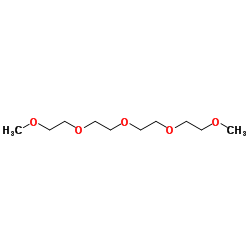Me-PEG4-Me

Me-PEG4-Me structure
|
Common Name | Me-PEG4-Me | ||
|---|---|---|---|---|
| CAS Number | 143-24-8 | Molecular Weight | 222.279 | |
| Density | 1.0±0.1 g/cm3 | Boiling Point | 275.3±0.0 °C at 760 mmHg | |
| Molecular Formula | C10H22O5 | Melting Point | −30 °C(lit.) | |
| MSDS | Chinese USA | Flash Point | 140.6±0.0 °C | |
| Symbol |

GHS08 |
Signal Word | Danger | |
|
Radical Cationic Pathway for the Decay of Ionized Glyme Molecules in Liquid Solution.
J. Phys. Chem. B 119 , 14472-8, (2015) Chemical stability of primary radical cations (RCs) generated in irradiated matter determines substantially the radiation resistance of organic materials. Transformations of the RCs of the glyme molecules, R(-O-CH2-CH2-)nO-R (R = CH3, n = 1-4) has been studie... |
|
|
Development of bipolar all-solid-state lithium battery based on quasi-solid-state electrolyte containing tetraglyme-LiTFSA equimolar complex.
Sci. Rep. 5 , 8869, (2015) The development of high energy-density lithium-ion secondary batteries as storage batteries in vehicles is attracting increasing attention. In this study, high-voltage bipolar stacked batteries with a quasi-solid-state electrolyte containing a Li-Glyme comple... |
|
|
Mechanism and Kinetics of Li2S Precipitation in Lithium-Sulfur Batteries.
Adv. Mater. 27 , 5203-9, (2015) The kinetics of Li2 S electrodeposition onto carbon in lithium-sulfur batteries are characterized. Electrodeposition is found to be dominated by a 2D nucleation and growth process with rate constants that depend strongly on the electrolyte solvent. Nucleation... |
|
|
In Situ-Grown ZnCo2O4 on Single-Walled Carbon Nanotubes as Air Electrode Materials for Rechargeable Lithium-Oxygen Batteries.
ChemSusChem 8 , 3697-703, (2015) The development of highly efficient catalysts is critical for the practical application of lithium-oxygen (Li-O2) batteries. Nanosheet-assembled ZnCo2O4 (ZCO) microspheres and thin films grown in situ on single-walled carbon nanotube (ZCO/SWCNT) composites as... |
|
|
Studies of electroosmotic flow and the effects of protein adsorption in plasma-polymerized microchannel surfaces.
Electrophoresis 30(11) , 1877-87, (2009) This paper presents a study of EOF properties of plasma-polymerized microchannel surfaces and the effects of protein (fibrinogen and lysozyme) adsorption on the EOF behavior of the surface-modified microchannels. Three plasma polymer surfaces, i.e. tetraglyme... |
|
|
Glow discharge plasma treatment of polyethylene tubing with tetraglyme results in ultralow fibrinogen adsorption and greatly reduced platelet adhesion.
J. Biomed. Mater. Res. A 79(4) , 788-803, (2006) Previous studies from our lab have shown that fibrinogen adsorption (Gamma(Fg)) must be reduced below 10 ng/cm(2) to significantly reduce platelet adhesion, and that radio frequency glow discharge (RFGD) treatment of polymeric films in the presence of tetraet... |
|
|
Fabrication of submicrometer biomolecular patterns by near-field exposure of plasma-polymerized tetraglyme films.
Langmuir 26(12) , 10203-9, (2010) Plasma-polymerized tetraglyme films (PP4G) have been modified by exposure to ultraviolet (UV) light from a frequency-doubled argon ion laser (244 nm) and characterized using X-ray photoelectron spectroscopy (XPS) and atomic force microscopy (AFM). XPS data in... |
|
|
Inhibition of monocyte adhesion and fibrinogen adsorption on glow discharge plasma deposited tetraethylene glycol dimethyl ether.
J. Biomater. Sci. Polym. Ed. 12(9) , 961-78, (2001) Monocytes and macrophages play important roles in host responses to implanted biomedical devices. Monocyte and macrophage interactions with biomaterial surfaces are thought to be mediated by adsorbed adhesive proteins such as fibrinogen and fibronectin. Non-f... |
|
|
Complement activation on poly(ethylene oxide)-like radiofrequency glow discharge-deposited surfaces.
J. Biomed. Mater. Res. A 96(1) , 150-61, (2011) Nonspecific protein adsorption, particularly fibrinogen (Fg), is thought to be an initiating step in the foreign body response (FBR) to biomaterials by promoting phagocyte attachment. In previous studies, we therefore prepared radiofrequency glow discharge (e... |
|
|
PEO-like plasma polymerized tetraglyme surface interactions with leukocytes and proteins: in vitro and in vivo studies.
J. Biomater. Sci. Polym. Ed. 13(4) , 367-90, (2002) Polyethylene oxide (PEO) surfaces reduce non-specific protein and cell interactions with implanted biomaterials and may improve their biocompatibility. PEO-like polymerized tetraglyme surfaces were made by glow discharge plasma deposition onto fluorinated eth... |